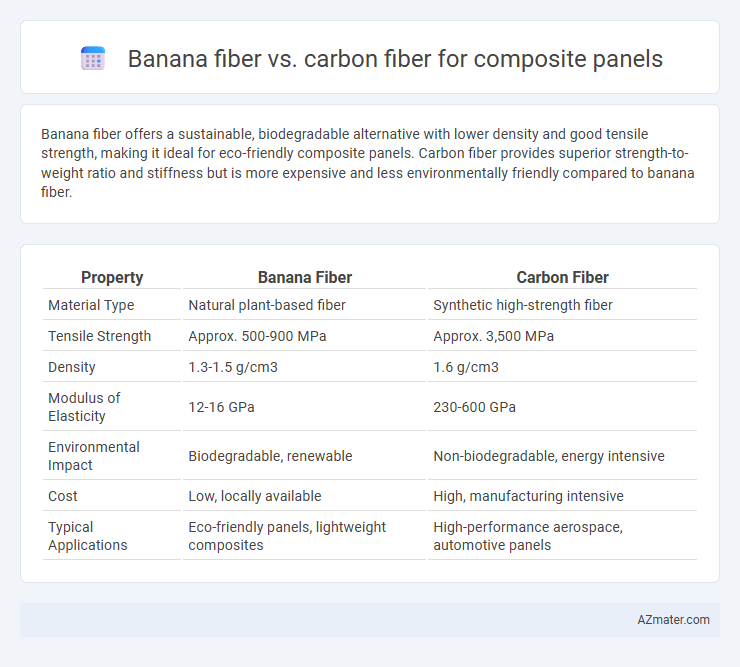Banana fiber offers a sustainable, biodegradable alternative with lower density and good tensile strength, making it ideal for eco-friendly composite panels. Carbon fiber provides superior strength-to-weight ratio and stiffness but is more expensive and less environmentally friendly compared to banana fiber.
Table of Comparison
| Property | Banana Fiber | Carbon Fiber |
|---|---|---|
| Material Type | Natural plant-based fiber | Synthetic high-strength fiber |
| Tensile Strength | Approx. 500-900 MPa | Approx. 3,500 MPa |
| Density | 1.3-1.5 g/cm3 | 1.6 g/cm3 |
| Modulus of Elasticity | 12-16 GPa | 230-600 GPa |
| Environmental Impact | Biodegradable, renewable | Non-biodegradable, energy intensive |
| Cost | Low, locally available | High, manufacturing intensive |
| Typical Applications | Eco-friendly panels, lightweight composites | High-performance aerospace, automotive panels |
Introduction to Composite Panels
Composite panels combine two or more materials to achieve superior mechanical properties and lightweight structure. Banana fiber, a natural, biodegradable reinforcement, offers sustainable strength and flexibility but has lower tensile strength and durability compared to carbon fiber. Carbon fiber provides exceptional stiffness, high tensile strength, and excellent durability, making it the preferred choice for high-performance composite panels in aerospace and automotive applications.
What is Banana Fiber?
Banana fiber is a natural cellulose fiber extracted from the pseudostem of the banana plant, known for its eco-friendly and biodegradable properties. It offers moderate tensile strength and lightweight characteristics, making it a sustainable alternative in composite panel manufacturing compared to carbon fiber. Unlike carbon fiber, which provides superior strength and stiffness at a higher cost and environmental impact, banana fiber contributes to reducing the carbon footprint in composite applications.
What is Carbon Fiber?
Carbon fiber is a high-strength, lightweight material composed of thin strands of carbon atoms bonded together in a crystalline formation, providing exceptional stiffness and tensile strength ideal for composite panels in aerospace, automotive, and sporting goods. Unlike banana fiber, which is a natural and biodegradable material derived from banana plants, carbon fiber offers superior durability, heat resistance, and structural performance. The use of carbon fiber in composite panels results in enhanced mechanical properties and long-term reliability, making it a preferred choice for high-performance applications.
Mechanical Properties Comparison
Banana fiber composite panels exhibit tensile strength ranging from 200 to 600 MPa, offering a renewable and biodegradable alternative with good impact resistance and moderate stiffness, typically around 8-12 GPa. Carbon fiber composite panels demonstrate superior mechanical properties with tensile strength exceeding 3500 MPa and stiffness above 230 GPa, resulting in exceptional rigidity and lightweight performance for high-strength applications. The trade-off between banana fiber's eco-friendliness and carbon fiber's high mechanical performance is critical when selecting materials for composite panel construction.
Environmental Impact and Sustainability
Banana fiber is a biodegradable, renewable resource with a low carbon footprint, making it highly sustainable for composite panels. Carbon fiber production involves high energy consumption and generates significant greenhouse gas emissions, negatively impacting the environment. Using banana fiber reduces reliance on non-renewable materials and promotes eco-friendly manufacturing processes in composite applications.
Cost Analysis and Economic Feasibility
Banana fiber composite panels offer a significantly lower material cost compared to carbon fiber, with raw banana fibers costing approximately $1.5 to $3 per kg versus carbon fibers priced between $20 to $50 per kg. The processing and manufacturing expenses for banana fiber composites are also reduced due to lower energy consumption and simpler fabrication techniques, enhancing economic feasibility for large-scale, low-to-medium performance applications. However, carbon fiber panels provide superior mechanical strength and durability, which may justify higher investment in high-performance sectors despite increased initial costs.
Manufacturing Process Differences
Banana fiber composite panels are manufactured using natural fibers extracted from banana plant stems, which undergo processes like retting, drying, and fiber treatment before being combined with bio-based resins through hand lay-up or compression molding. Carbon fiber composites involve high-temperature carbonization of polyacrylonitrile (PAN) precursor fibers, followed by precision weaving and infusion with thermosetting or thermoplastic resins using advanced techniques such as vacuum-assisted resin transfer molding (VARTM) or autoclave curing. The manufacturing of banana fiber composites is more environmentally friendly and less energy-intensive, whereas carbon fiber processes require costly high-temperature ovens and controlled environments, resulting in higher production complexity and material performance.
Applications in Industry
Banana fiber composite panels offer sustainability benefits and are widely used in automotive interiors, packaging, and construction due to their biodegradability and moderate strength-to-weight ratio. Carbon fiber panels dominate aerospace, automotive, and sporting goods industries where high strength, stiffness, and lightweight properties are critical for performance and fuel efficiency. Industrial applications prioritize carbon fiber composites for structural components demanding superior mechanical properties, while banana fiber panels are favored in eco-friendly and cost-sensitive markets.
Performance in Real-World Conditions
Banana fiber composite panels exhibit excellent biodegradability and low weight, offering moderate tensile strength suitable for eco-friendly applications, whereas carbon fiber panels provide superior strength, stiffness, and durability under harsh real-world conditions. In high-stress environments like aerospace or automotive sectors, carbon fiber outperforms due to its high fatigue resistance and thermal stability. Moisture absorption and UV degradation impact banana fiber's long-term performance negatively, limiting its use in outdoor or extreme conditions compared to carbon fiber's resilience.
Future Prospects and Innovations
Banana fiber offers a sustainable and biodegradable alternative to carbon fiber in composite panels, with ongoing research focused on enhancing its mechanical properties and durability through nanotechnology and bio-based resins. Innovations in hybrid composites combining banana fiber and carbon fiber aim to optimize strength-to-weight ratios while reducing environmental impact in automotive and aerospace applications. Future prospects include scalable manufacturing techniques and functionalizing banana fibers for improved compatibility with advanced polymer matrices, paving the way for eco-friendly, high-performance composite panels.

Infographic: Banana fiber vs Carbon fiber for Composite panel
 azmater.com
azmater.com